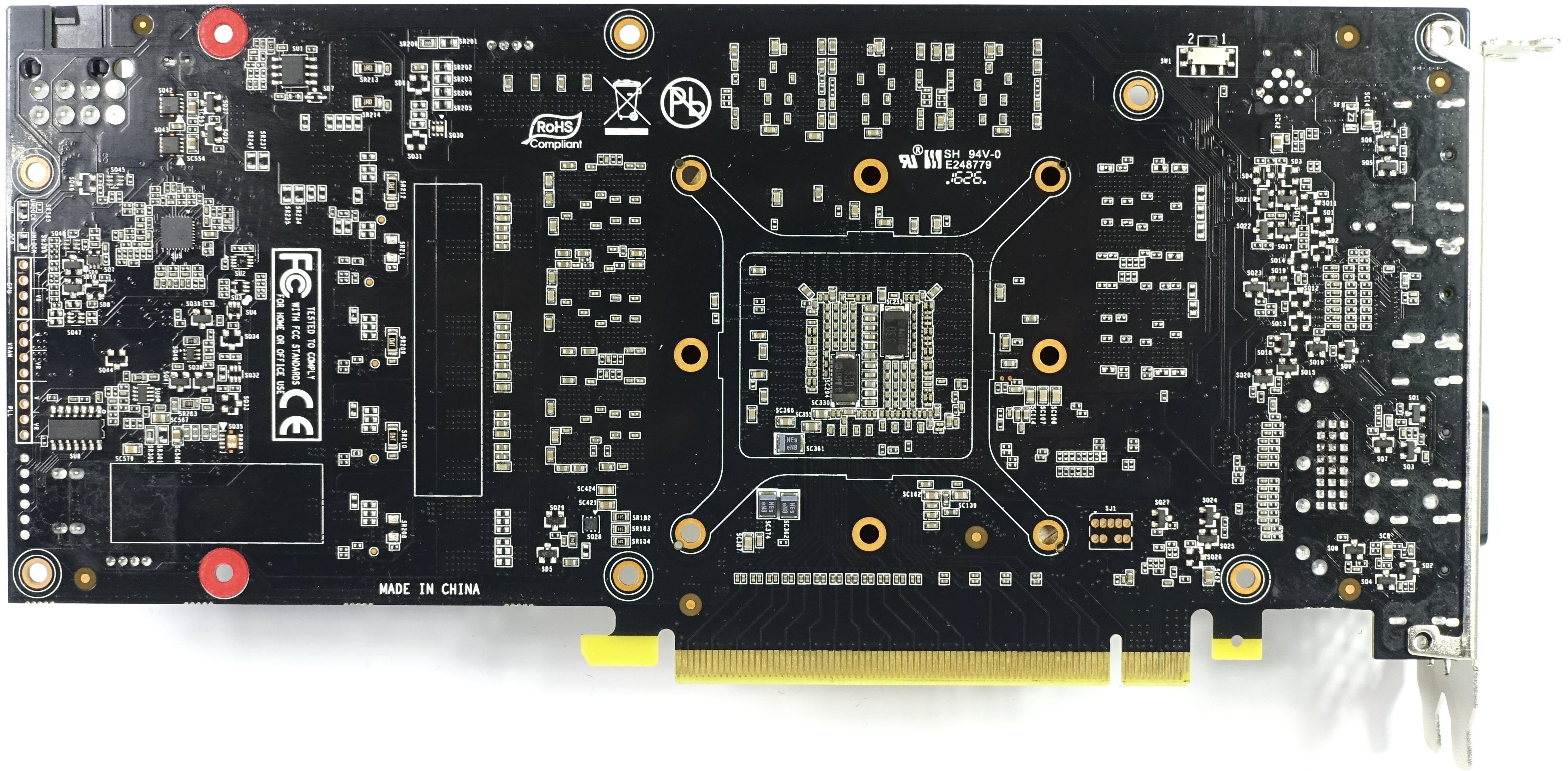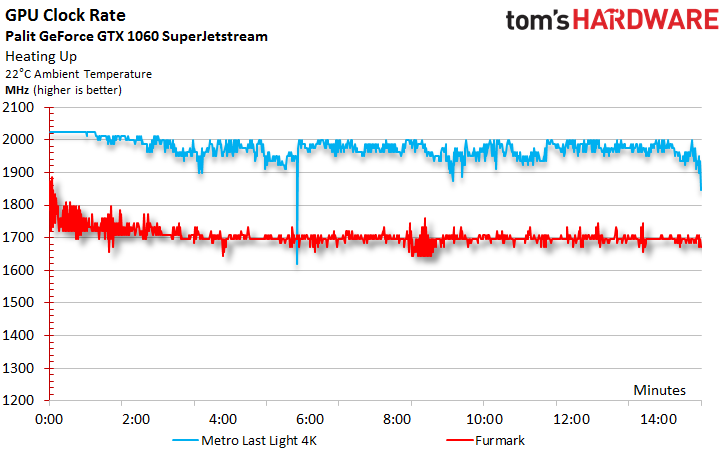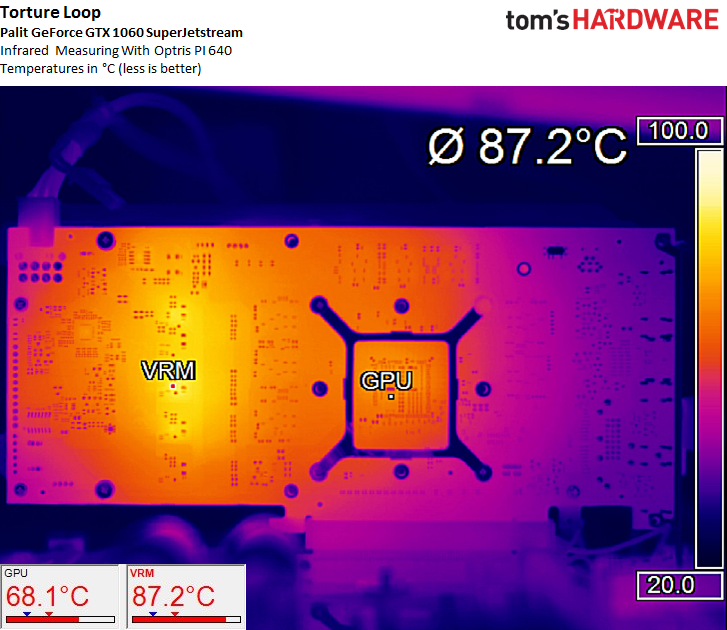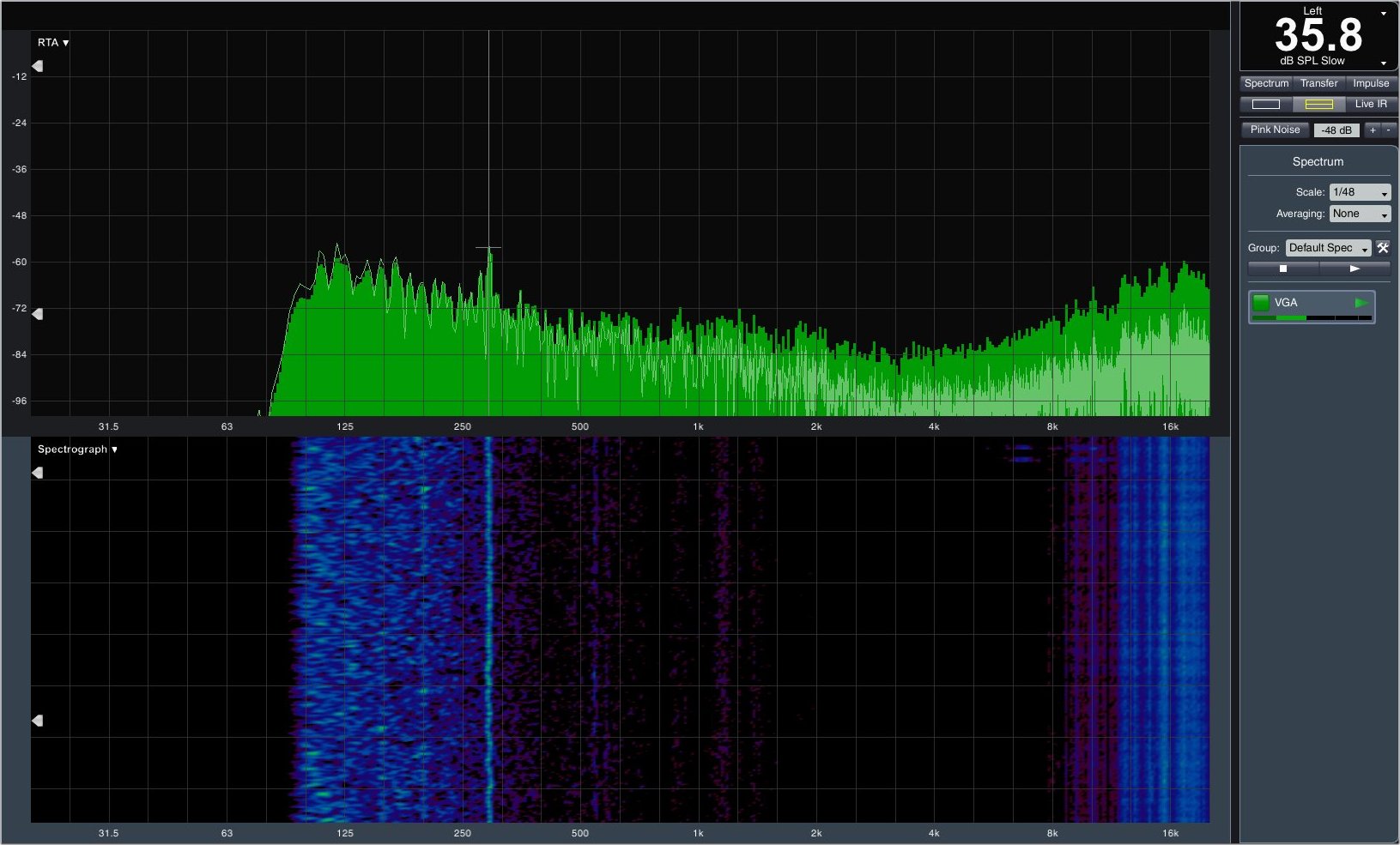Nvidia GeForce GTX 1060 Graphics Card Roundup
Palit GeForce GTX 1060 Super JetStream
Why you can trust Tom's Hardware
Palit's GeForce GTX 1060 Super JetStream is virtually identical to Gainward's GeForce GTX 1060 Phoenix GS, with only a few small variations. One thing they share in common, unfortunately, is a lack of availability in the U.S.
Maybe this shouldn't come as a surprise. After all, the two cards come from the same factory. Where does this leave the Super JetStream in our tests, though, and could a few differences set Palit's card apart from Gainward's?
For a long time, the Super JetStream represented the top of Palit's factory-overclocking efforts. Only the higher-end GeForce GTX 1070 and 1080 have more aggressively-tuned GameRock Premium Edition models. In the GTX 1060 market, Palit decided against such a halo offering (and with good reason, as unnecessary fragmentation costs money).
Technical Specifications
MORE: Best Graphics Cards
MORE: Desktop GPU Performance Hierarchy Table
MORE: All Graphics Content
Exterior & Interfaces
The Super JetStream's fan shroud is made of black plastic with metal highlights. This cover is designed to be modular, as are the fans. Thus, a Palit card can easily be transformed into a Gainward model and vice versa by simply removing four screws.
Weighing in at 31 ounces (878 grams), the Super JetStream is moderately hefty, yet quite compact. Similar to the Gainward model, it measures only 24cm long, 11.7cm tall, and a substantial 4.7cm wide, practically requiring three expansion slots. Needless to say, you'd have a hard time wedging it into a mini-ITX-based system.


The back of the board is covered by a single-piece plate that lacks ventilation holes and does nothing to help with cooling. Because of the backplate, though, you must plan for an additional one-fifth of an inch (5mm) of clearance to avoid collisions with your CPU's cooler.
The top of the card features a backlit Palit logo with customizable RGB LEDs. A six-pin power connector is rotated 180° and positioned at the end of the PCB. This makes sense from a technical point of view, since the cooling fins don't need to be made any shorter.
A closer look at the heat pipes on the bottom reveals that they aren't embedded in a cooler block or heat spreader. Instead, they lay flat behind the base of the board (we already saw the same concept on Gainward's implementation). Whether this budget-oriented approach holds up any better in our tests remains to be seen.
Horizontally-oriented fins allow some waste heat to escape from an externally-facing slot bracket loaded with ventilation holes. This also applies to the card's other end, though, where hot air dumps out into the middle of your case. Good circulation is critical as a result.


The slot cover exposes five outputs, four of which can be used simultaneously to drive multi-monitor configurations. In addition to one dual-link DVI output (which lacks an analog signal), you also get one HDMI 2.0 interface and three DisplayPort 1.4-capable connectors.
Board & Components
The PCB that Palit and Gainward use features some prominent differences compared to Nvidia's reference design.
Right off the bat we see four power phases, just like Nvidia's card. Three are meant for the GPU and one corresponds to the memory. Two of the three GPU phases are fed by the auxiliary power connector. The third GPU phase and the one for the memory get power from the motherboard slot.
While, in theory, Palit's PCB offers the option to use one more power phase, the company went with a rarely-used and rather inexpensive NCP81174 for its PWM controller, which can only control up to four phases. Thus, the vacant emplacement you see in the image above could only have been populated by another parallel regulator circuit (via doubling).
The three GPU phases utilize a highly integrated Vishay SiC632, which combines the gate driver, high- and low-side MOSFET, and Schottky-diode in one convenient package. Meanwhile, the memory is driven by a pair of N-Channel MOSFETs, including one SM4503NHKP (30A, high-side) and one SM4377NSKP (50A, low-side), both manufactured by Sinopower. The MOSFETs are also fairly cost-effective choices.
Overall, the board reflects that Gainward didn't spend big on pricey components. Even the Foxconn Magic chokes are middle-of-the-road. They get their job done in a rather unremarkable way.
Two capacitors are installed right below the GPU to absorb and equalize voltage peaks.
Only six of the eight available memory emplacements are populated with Samsung K4G80325FB-HC25 modules. Each one adds 8Gb (32x256Mb) and operates at voltages between 1.305 and 1.597V, depending on clock rate. In total, they add up to this card's 6GB of GDDR5.
Power Results
The GPU Boost frequency and core voltage curves are particularly interesting to us. Our data shows that frequency drops significantly as the card heats up during a gaming session. Whether that's due to a higher-quality GPU or the clock rate's higher starting point compared to Gainward's version is a question we can't easily answer.
Otherwise, we observe a lot of similarities. The 2025 MHz we initially measured falls to an acceptable 1949 MHz under load. Voltage behaves similarly: we measured 0.975V on average, with readings varying between 1.025 and 0.9V. All of this points back to GPU Boost 3.0 and a relatively low power target that limits consumption to a maximum of 130W.
The lowest GPU clock rate measured with an idle card is about 253 MHz, just like Gainward's take on the same implementation.
We took our measurements using a variable low-pass filter, so we mention short load peaks only as a side note (see the grayed-out bar in the chart below), since those peaks are rarely relevant in practice.
One set of readings that does stand out is the noticeably higher gaming power consumption, especially at lower resolutions. Meanwhile, up top, Palit's GeForce GTX 1060 Super JetStream fares the same as Gainward's GeForce GTX 1060 6GB Phoenix "GS". Since Palit is slightly faster at 1080p, though, the results remain proportionate.
A low power target causes GPU Boost to cut the voltages dramatically during our stress test, resulting in power consumption numbers that are lower than what we measure during a worst-case gaming workload.
Power Connector Load
Load distribution from the four voltage regulators to their respective power phases isn't problematic at all. However, there's little headroom for overclocking, even if it wasn't already limited by the firmware's power target and voltage settings.
Here's the data for the gaming and stress tests:


Power consumption on its own only tells us part of the story. The PCI-SIG specifies a maximum of 5.5A at the motherboard slot, and we're showing a reading of about 5A, which puts Palit's GeForce GTX 1060 Super JetStream in the green (though a bit higher than Gainward's card).
Of course, we have the data for measured currents as well:


The Cooler & Its Performance
Although we already covered Gainward's cooler, it's worth discussing Palit's as well since there are a couple of details that differ. Like the backplate Gainward uses, this one is purely aesthetic; it doesn't help cool the PCB at all. Four screws secure it to the top of the board, shielding the card from curious customers.
The fan shrouds that Gainward and Palit use look a little different. Gainward's card is equipped with slightly more powerful fans (6.6W, 2700 RPM max.), while Palit's Super JetStream only includes 4.8W models, which top out at 2500 RPM. In addition, the 9cm blades employ a different geometry, which in Palit's case is slightly wavy. Their surfaces is smooth, without grooves.
It's also worth mentioning that the fans rotate in opposite directions. This should help improve efficiency due to more chaotic air flow.
Again, the delicate-looking cooler sports horizontally-oriented fins, as well as a quartet of 4mm heat pipes made from sintered composite material. Those pipes are not integrated into the bottom of the cooler. Instead, they merely touch the back of the thin base plate. Expensive copper is nowhere to be found.
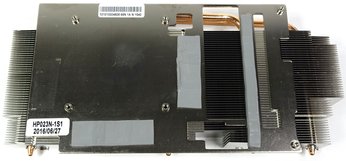

We're glad to see that the base plate has a specific area to help cool the MOSFETs. However, the coils have to live without the benefit of active cooling.
Registering between 162 to 163°F (72 to 73°C) during our gaming loop, and a maximum of 169°F (76°C) in a closed case, the cooler does a fair job. It would almost assuredly perform better if the heat pipes were attached more securely, though. The stress test shows a similar picture.
The temperatures we measure on Palit's GeForce GTX 1060 Super JetStream are one to two Kelvin above Gainward's, which could be due to the higher power numbers we observed and its weaker fans.
Measurements collected with the backplate removed also reveal acceptable values. A peak of approximately 180°F (82°C) from the VRMs is reasonable, in our opinion. Interestingly, the different fan geometry clearly helps cool the PCB more efficiently.
With readings around 189°F (87°C), our stress test doesn't reveal any serious problems.
Palit's cooling performance is basically acceptable. We get the impression that one member of the finance team was assigned to each engineer, keeping costs in check more than enthusiasts like to see.
Sound Results
Hysteresis is not an issue for most manufacturers. However, Palit implemented a fan curve with too-low of an initial rotational speed for the transition between passive and active mode. As a result, the fans simply stop, and need to be restarted repeatedly. Even the best hysteresis won't help when a manufacturer overestimates the quality of its components this grossly.
A minimum value of 400 to 450 RPM (~600 RPM as a start-up pulse) would have been necessary, corresponding to about 18 percent as a PWM controller signal. Knowing this helps us manually modify the fan curve accordingly, thus getting rid of the annoying start-stop cycles.
When the card is idle, noise is not measurable due to a semi-passive mode. A reading of 35.8 dB(A) under load is acceptable, but not great. So much air has to be moved through the thermal solution because Palit's cooler isn't as efficient as it should be. Spending a few dollars more would have gone a long way. On the bright side, we measure very little low-frequency bearing noise. What remains is the sort of acoustic energy that's easily absorbed by a case with sound insulation.
Palit GeForce GTX 1060 Super JetStream
Reasons to buy
Reasons to avoid

MORE: Nvidia GeForce GTX 1080 Roundup
MORE: Nvidia GeForce GTX 1070 Roundup
MORE: All Graphics Content
Current page: Palit GeForce GTX 1060 Super JetStream
Prev Page MSI GeForce GTX 1060 Gaming X 6GGet Tom's Hardware's best news and in-depth reviews, straight to your inbox.

Igor Wallossek wrote a wide variety of hardware articles for Tom's Hardware, with a strong focus on technical analysis and in-depth reviews. His contributions have spanned a broad spectrum of PC components, including GPUs, CPUs, workstations, and PC builds. His insightful articles provide readers with detailed knowledge to make informed decisions in the ever-evolving tech landscape
-
Achaios @Igor: I really appreciate your articles. I have one small request: PLEASE consider adding benchmarks results from 3D MARK FIRESTRIKE so that we can compare your results with our GPU's. Really appreciated your "Das große Radeon RX480 Test-Roundup - Teil 1" too, though again, there are no 3D MARK FIRESTRIKE results.Reply -
bloodroses Darnit, the Zotac and Gigabyte mini models weren't covered. I was curious to see how those two compare vs. the EVGA model since I'm working with limited space inside my case.Reply -
agent88 I bought a retail MSI Geforce GTX 1060 Gaming X card last month and it was defaulted to OC mode by default. This is the same as the test version that the press received. Wondering if MSI is shipping this version to all consumers now or if I just got lucky with a "golden sample". Also, MSI provides both the MSI gaming app and afterburner software. The gaming app offers 1-click option to choose the OC mode. AReply -
shrapnel_indie Good to see a roundup... However, I think the 3GB and the 6GB belong in the same category as much as the RX-470 and RX-480 do. That is: they don't.Reply -
FritzEiv We're working on getting more cards in for all categories (1080, 1070, 1060), including from Asus, which is working on getting us cards. In fact, we'll have an update to our 1070 roundup shortly (2 new cards). And we're working on a 480 roundup as well.Reply -
mikeangs2004 Reply19457023 said:Darnit, the Zotac and Gigabyte mini models weren't covered. I was curious to see how those two compare vs. the EVGA model since I'm working with limited space inside my case.
they are kind of for the niche market just like in the days of low profile units -
Ancient1 Regarding the EVGA GTX 1060 SC :Reply
Could someone who disassemble it post the measurements ( WxHxL ) of the HEATPIPE ?? I plan on carving a Copper Heatsink, rather than Thermal Pads.
I am also thinking about HS for the memory etc , along the Pipe. But it will impact AirFlow and might degrade the HeatPipe efficiency as , to my knowledge, Heatpipe depends on temperature difference between the cooled GPU and the Heat Expelling (to the fins) areas of it.
Please post, Google will find it :)
Thanks in advance




